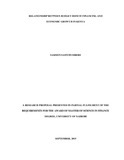| dc.description.abstract | The study main objective is to establish the This study seeks to find out the relationship between
budget deficit financing and economic growth in Kenya. for Kenya, the central government
budget deficit shows double digit levels in almost each year since 1963. These budget deficits
and a host of other factors could be some of the causes of low investment and slow economic
growth. Study used descriptive research design. A descriptive study is concerned with finding
out who, what, where, when, or how much (Cooper and Schindler, 2006). This research was
descriptive because it was concerned with discussing Relationship between Budget Deficit
Financing and Economic Growth in Kenya affects. The data collection of this study was
secondary data. The data collection of secondary data involved analysis of Kenya’s budget from
year 2005 – 2014, The researcher also utilized reports from office of the controller of Budget,
Parliamentary Budget reports and the researcher also surfed the internet and websites in order to
find more information and gather the electronic journals or articles that helped the researcher to
do the research well. The study found out that Findings of the study indicate that Inflation was at
lowest point in 2010 at 0.03%. From the findings the higher the Budget deficit the higher the
inflation this is well seen in 2007 when the budget deficit was high at 5.3% and inflation was at
31%. Figure 4.2 indicate that The exchange in 2005 was 7.2% drop to 6.7% in 2009 and begin to
trade highly at above Ksh. 80 in the period between 2012 to 2014. Government Budget in Kenya
averaged 2.93 percent of GDP from 1998 until 2014, in 2005 the BD was 0.01% raised to 2.6%
in 2007, drop to 0.2% in 2009 sharply increased to 5.2% in 2010 and recording highest Budget
deficit equal to 8 percent of the country's Gross Domestic Product in 2014. The Coefficient of
Determination (R2) of 0. 843 (see table 4.2) shows that the independent variables included in the model explains 73% of the variations in the dependent variable. Therefore the model is a good fit to the relationship. The result has F-Statistics produced (F=1.242) was significant at 0 per cent level (Sig. F<.000) thus confirming the fitness of the model. | en_US |

